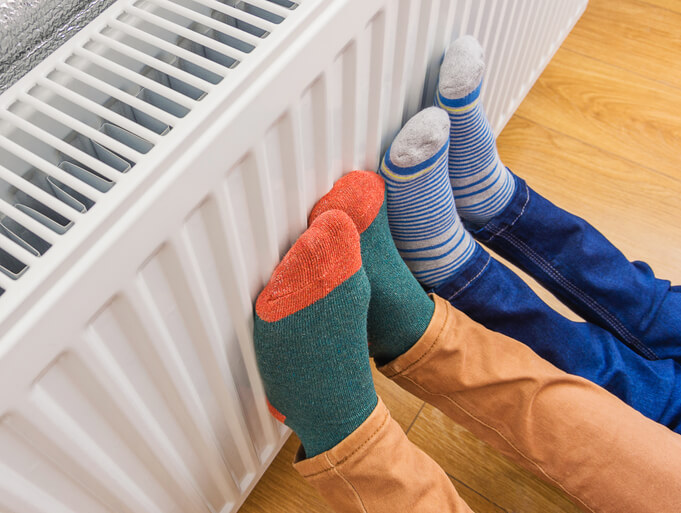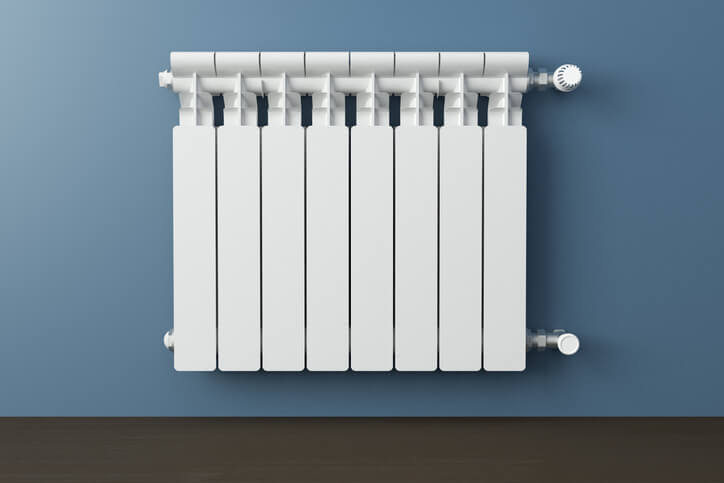Heating systems can be classified in different ways: depending on the type of energy, the emission model or its use.
In Spain 60% of homes have some type of heating system (INE). Today there are many options available and in this article we want to talk about the main types of heating that you can install when making a reform.
Types of heating systems according to energy
These are the main types of energy used in heating systems:
- Natural gas
- Electric heating
- Propane gas
- Butane gas
- Gasoil
- Heat pump
- Pellet stoves
Natural gas heating system
Natural gas heating is one of the most widely used, as it is a comfortable and safe system. In addition, the price of fuel is affordable compared to other options, although as we have seen it can also be affected by fluctuations.
The system is based on the combustion of gas in a boiler to heat water that is then circulated through the radiators or underfloor heating of the house. The boiler also generates domestic hot water (DHW). It is recommended for places with cold climates where there will be an intensive use of heating.
This system requires a connection to the natural gas network. In addition, the installation is more complex than other systems (such as electric heating), as a whole system of pipes for radiators or underfloor heating is required . This means that the work requires a higher investment, although this is later compensated by the lower cost during use (lower price per kWh).
Electric heating system
Electric heating is also a widely used system, although its use changes with respect to the previous one. In this case its installation is usually simple, but the cost per kWh is one of the highest. Therefore, it is a recommended heating system for temperate places where it is not going to be used frequently, such as a weekend house.
The installation can be done using different emitters, such as electric accumulators, which can be charged with heat during the off-peak hours of the tariff and release it during the day; electric convectors, which are “plug and play” radiators; or radiant floor heating (also called radiant wire), similar to the one used with gas, but which works with electricity.
If you plan to use this heating system you should review the electrical power you have contracted, as you may need to increase it. This means an additional expense in the bill, but in exchange you get a clean, safe energy with a continuous supply.
Propane gas heating system
Propane gas heaters are a good alternative to use a gas heating system in those cases where there is no connection to the natural gas network.
Of course, propane is more expensive than natural gas and you need to have some kind of supply, either through a tank or cylinders .
Butane gas heating system
Butane heating systems are very useful for certain applications, such as terraces, picnic areas or houses that are used occasionally. They are systems that use the well-known butane cylinders that are served at home or can be purchased at gas stations. These cylinders are used in stoves or boilers of various types: mobile indoor stoves, outdoor stoves, watertight boilers (which can supply hot water to the radiator circuit) or watertight fireplaces.
Therefore, it can be a very simple option in some cases, although on the downside it has the dependence on gas cylinders, in addition to a characteristic odor that is produced when this fuel is burned.
Oil heating system
Oil or gasoil systems are also an option for homes that do not have access to any gas supply network. In this case it is necessary to install a tank and an oil boiler. In this way you can feed a system of radiators and have ACS. Its price in use is higher than natural gas, but it is usually a cheaper option than propane and butane.
Heating system with heat pump
Heat pump systems are one of the most efficient systems available today. They only require electricity to power the equipment and the heat pump extracts energy from the air, water or ground to send it into the home.
The advantage of this system is that it is also possible to perform the reverse process, i.e. to remove the heat from the house, thus having an air conditioning system for both winter and summer. winter as well as for summer.
The downside is that it does not distribute heat very well inside, so it works best in small spaces, and is most efficient in places where the outside temperature is not very low.
Pellet stove heating system
Pellet stoves are nowadays the most convenient way to use biomass. Pellets can be found very easily and their cost is lower than diesel, being safer and less polluting.
On the other hand, biomass boilers are somewhat more expensive, although their installation is simple. There are small models that do not need a ventilation system to be placed in rooms, large stoves that can bring hot air to the whole house, hydrostoves or thermo-stoves that can heat water from the radiator circuit or underfloor heating, and even boilers that can also produce DHW.
Types of heating systems according to the emitter used
Depending on the emitter used, heating systems can be by:
- Underfloor heating
- Radiators

Underfloor heating systems
Underfloor heating is a tube system placed under the pavement, which makes the heat distribution more uniform and efficient, although its installation requires a significant amount of work .
There are two main types:
- Water underfloor heating: the circuit consists of pipes through which hot water circulates. It can be used with gas systems, air (aerothermal) or ground(geothermal) heat pumps, pellet boilers, gasoil, etc.
- Electric radiant floor: the circuit is an electric wire that generates heat. Compared to the previous one, its installation is easier, but the consumption during its use is higher.
Radiator heating systems

Radiators are emission elements widely used in Spain. They are easily installed in walls and can be powered by hot water or electricity.
Types of heating systems according to use
Depending on their use, heating systems can be individual or central:
- Individual heating systems: are those for individual houses or apartments, where the boiler is usually installed in the house itself.
- Central heating systems: those that supply a community of neighbors, where the boiler or pump is in an isolated space.
What is the best heating system?
I’m sure you’re asking yourself questions like: What is the most economical heating system? What is the most efficient heating? And what is the best heating when renovating?
These are questions that have a difficult answer, since choosing the best heating system for you depends on many factors: where your home is and what the weather is like, whether it has access to the gas network, what use you make of that home, and so on.
In short, the best heating best heating system will be the one that best suits your home and your needs at the lowest and your needs at the lowest cost. In any case, in Paratureforma you have the best prices on stoves, underfloor heating systems, flue pipes and much more.
Factors affecting kW consumption
Climate zone → More kW is needed in cold regions than in temperate zones.
Type of insulation → A well-insulated house needs 30-40% less power.
Number of rooms and layout → Open spaces require less kW per square meter than many small rooms.
Orientation of the house → If it receives a lot of sunlight, the heating requirement will be lower.
How many kW do I need per square meter?
In a medium insulated dwelling, 100 W per m² is recommended. For example, for 50 m² → 5 kW, for 100 m² → 10 kW.
How does insulation influence the kW required?
Well insulated: 60-80 W/m²
Medium insulated: 100 W/m²
Poorly insulated: 120-150 W/m²
How does the weather affect the required kW?
In cold areas, 20-40% more power is needed than in temperate climates.
Which heating system to choose according to kW?
Less than 5 kW: Electric radiators, underfloor heating.
5-10kW: Heat pumps, gas boilers.
More than 10 kW: Oil boilers, biomass, central heating.


